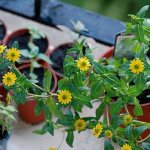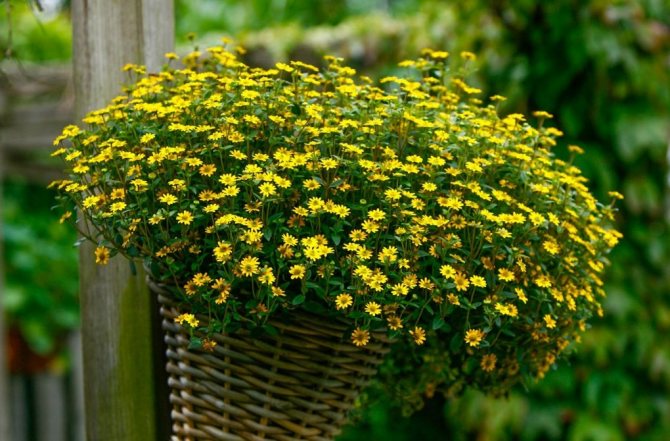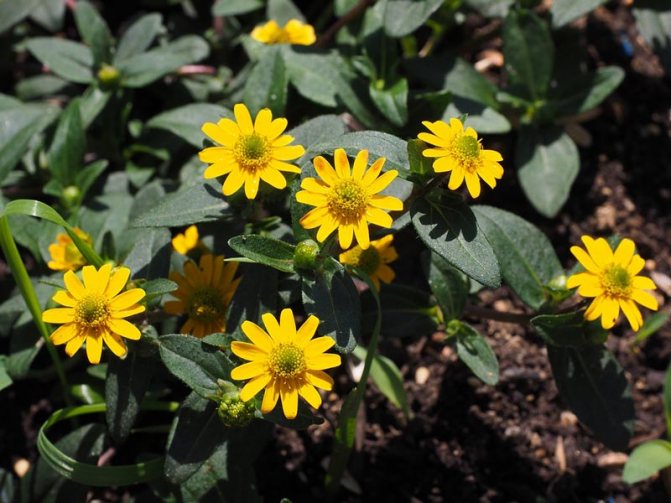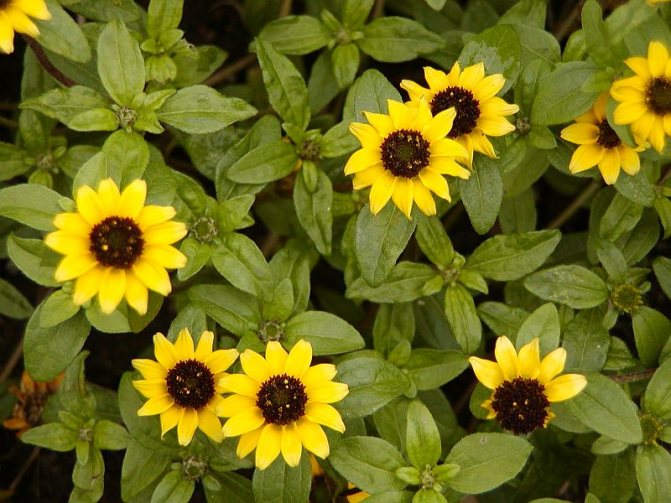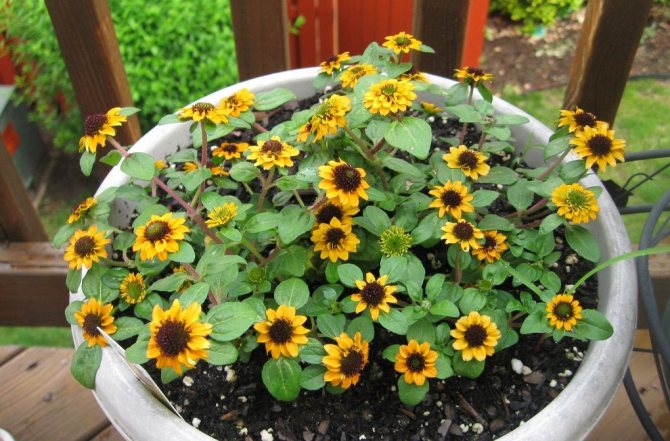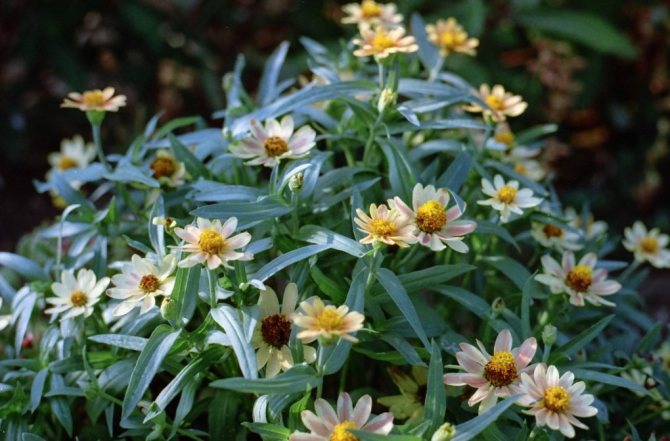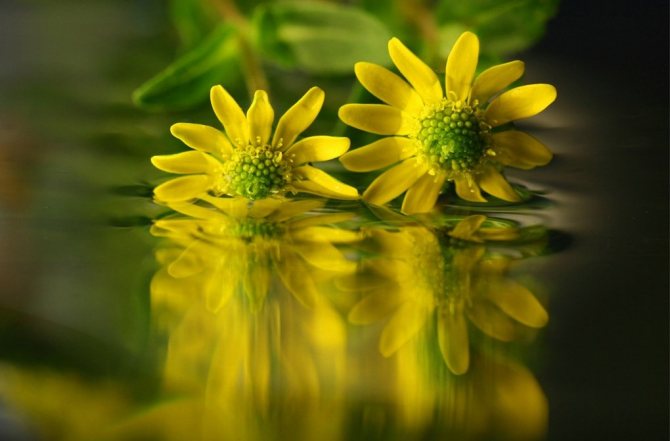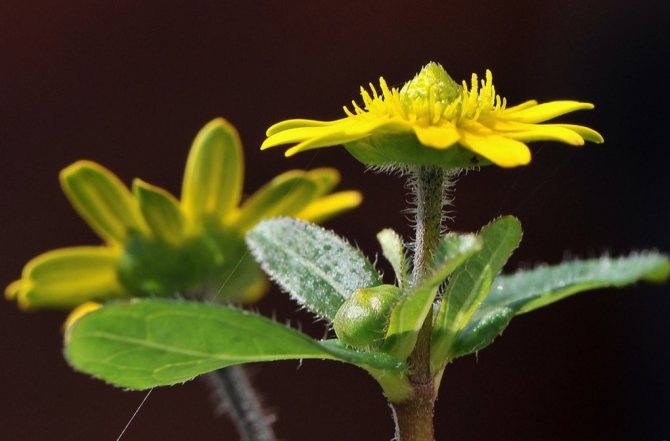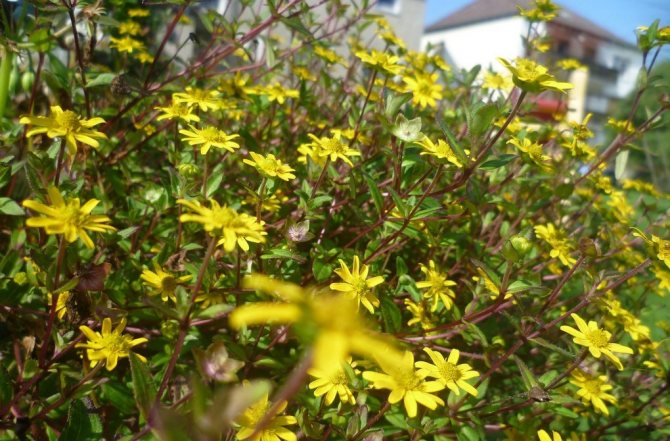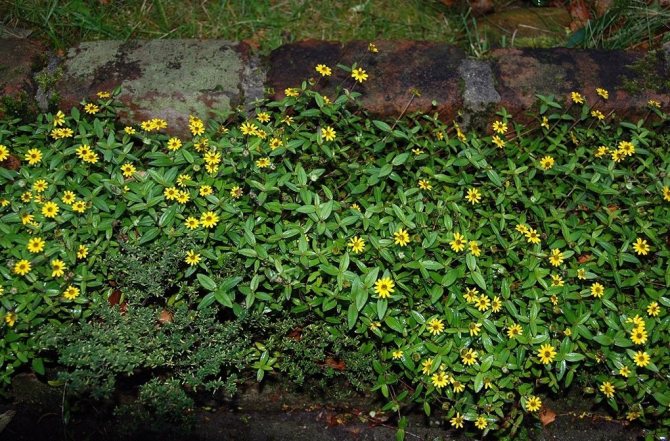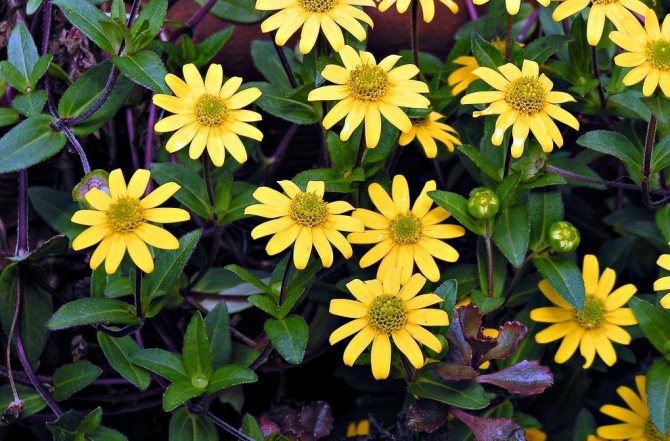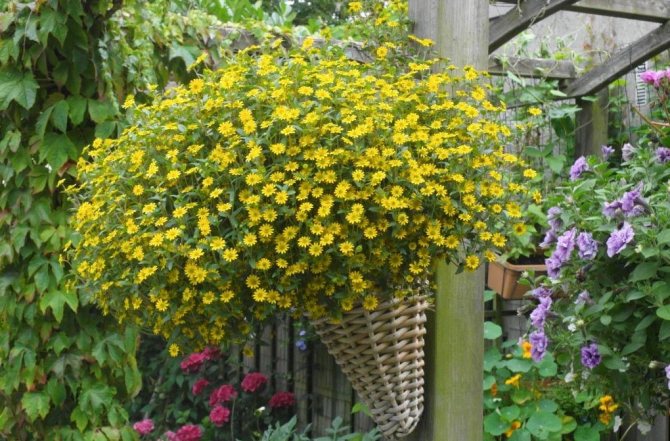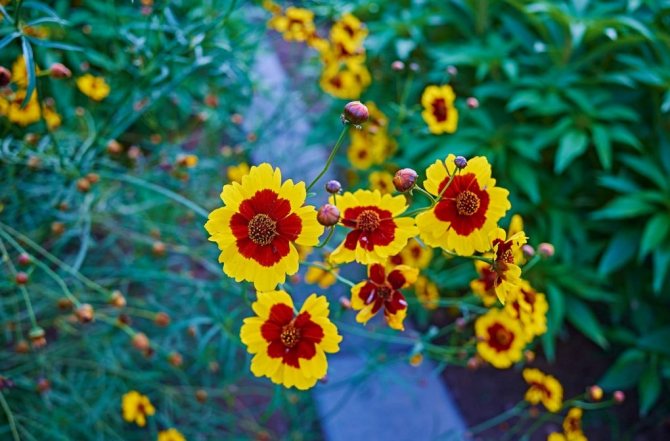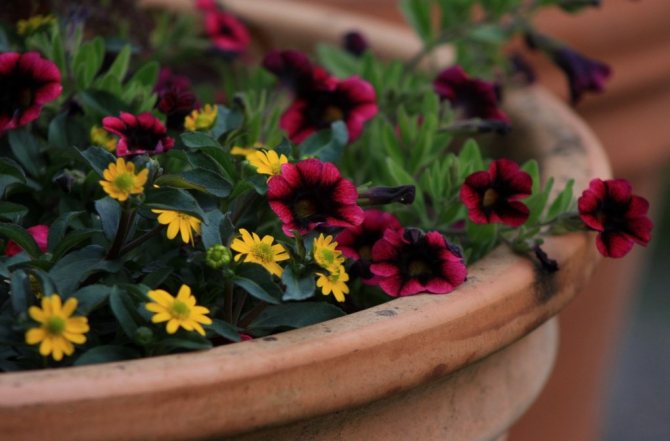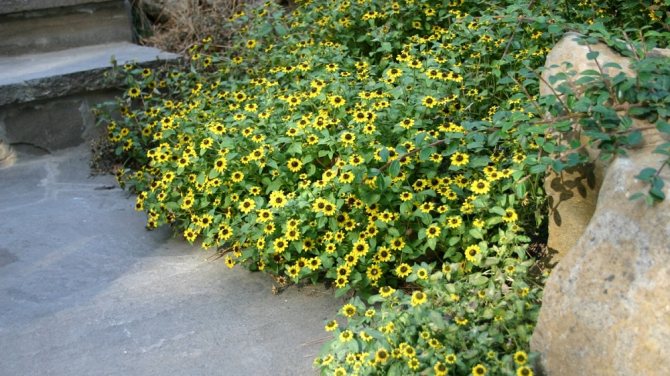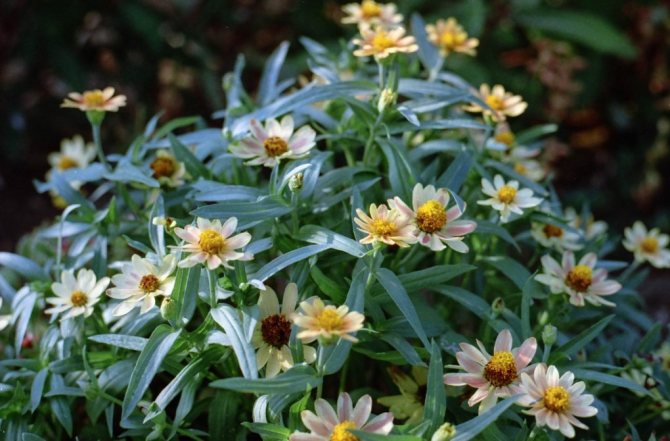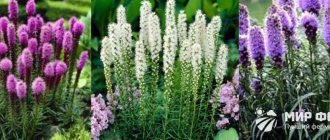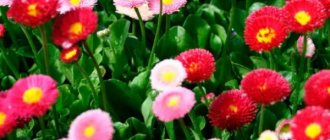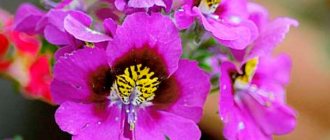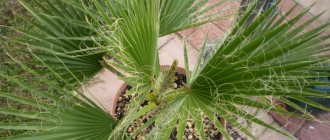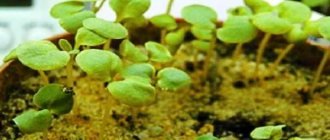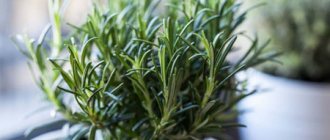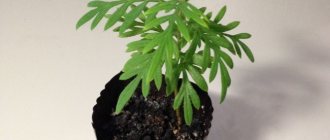A short herbaceous annual or perennial plant Sanvitalia is a member of the Asteraceae or Asteraceae family. This genus unites only 7 species. In natural conditions, such plants can be found in Central and North America. This genus was named after the Italian, Sanvitali, who was a botanist. The most popular among gardeners is such a type as recumbent or prostrate sanitary (Sanvitalia procumbens), it has been cultivated since the 18th century.
Description
Among the wide variety of varieties of sanvitalia, there are annual and perennial specimens. The plant has highly branched shoots that spread along the ground. In height, it reaches only 15-25 cm, but the width of the bush will easily exceed 45 cm. Lateral processes are actively formed from leaf rosettes on their own without pinching.
The leaf plates are smooth, dark. Leaf shape is ovoid or elongated elliptical with a pointed end and smooth edges. The average leaf size is 6 cm. The color of greenery and shoots is uniform, dark green.
During the flowering period (from July to October), the entire crown of the sanvitalia is abundantly covered with single flowers in the form of baskets. The color of the petals ranges from whitish and light yellow to rich terracotta. There are varieties with simple flowers (where the petals are located in one row) and complex (multi-row) inflorescences. The core can be bright orange or dark brown. The flower is small, 15-25 mm in diameter. After sowing on a young plant, the first buds appear in 2-2.5 months. Flowering continuously, new buds immediately appear in the place of wilted ones.
Description of the plant
Sanvitalia is a representative of the family. The flower got its name in honor of the Italian botanist Sanvitali, who first described it. It is a creeping plant with highly branched shoots that do not need to be pinched. These are mainly annuals, but there are also several perennial species in the genus.
Sanvitalia's green leaves are opposite to each other. Their shape is oval, slightly elongated. Bushes grow well in width and quickly cover a plot of land with low, 15-20 cm stems.
Flowering sanvitalia
Inflorescences are small baskets. Their tubular flowers, located inside, are most often colored brown, and the reed flowers, framing the inflorescence, are yellow, white or orange. They look like tiny sunflowers.
Flowering continues throughout the summer and the warm months of autumn. Small seeds remain viable for 2 years. There are varieties of sanvitalia with large and double flower shapes.
Varieties of sanitation
Although sanvitalia is quite diverse in the wild, less than two dozen varieties are used in culture. Among them, the following are especially distinguished:
- Spread out. At a low height, lateral shoots spread to 45-55 cm. The plant is densely covered with orange flowers with brown eyes.
- Orange Sprite. It stands out with semi-double orange baskets of flowers and a darker shade of greenery.
- A million suns. A short plant covered with yellow daisy-shaped flowers. The core is lush, black. Suitable for growing in hanging pots, from which twisted shoots hang down.
- Aztek Gold. Flowers of this variety have a yellow core and petals that cover the green crown with golden stars.
- Bright eyes. The variety was named for the expressive color of the buds. The black eye of the core is framed by orange petals.
- Ampelnaya. It features beautiful side shoots that look spectacular in hanging flowerpots and balcony compositions.
- Honey saved. Creeping shrubs have a lot of flowers that are constantly being updated. The plant forms a continuous cover on the lawn. The petals are honey-yellow, and the cores are dark brown.
Sanitation varieties
One of the most popular plant varieties is Sanvitalia Procumbens. It has several varieties, for example, Sunshine and Bright Eyes. Other cultivars are also known.
The outstretched "Suns"
- one of the most common varieties. This is an annual culture. Ideal for areas where bare soil is required as it is a creeping variety. Branching shoots with small bright flowers form a dense floral carpet. The stems grow up to 45 cm.The height of the bush itself does not exceed 15 cm.
The variety loves the sun and warmth, but tolerates both rainy and dry weather quite calmly. Small flowers, effectively located above dense foliage, delight with flowering from early summer to mid-autumn. The petals are bright yellow. The core is brown. This variety is easy to grow. You can grow through seedlings, or you can sow seeds directly into open ground. It can be grown both in hanging pots and in flower beds and flower beds.
Outstretched "Bright eyes"
- ampelous sanitation. This ground cover crop is distinguished by its unpretentiousness and numerous flowering from June to the first frost. Branched shoots are covered with dark green oval leaves. The petals are bright orange and the core is black. The variety loves sun and warmth. Looks great in hanging baskets, balcony boxes, mixborders and flower beds.
Sanvitalia Gold Breid from Gavrish (Gold Breid)
Is an annual ground cover variety. Height does not exceed 20 cm. Shoots grow strongly. The leaves are oval. The inflorescence is a yellow basket with a black center. Seeds are sown for seedlings in early spring, and in open ground they are planted in May. The beginning of flowering is mid-July. Flowering ends in mid-autumn. The cultivar is a sun lover.
Colorful ridges, borders, rockeries are the areas of use for Gold Braid.
Gold Braid
Aztek Gold
Is an annual. Long shoots are up to 40 cm long. Abundant flowering is represented by small flowers that look like golden suns. The petals are yellow, and the core has a slightly greenish tint. The plant is also a ground cover.
Reproduction
Sanvitalia is propagated by seeds. This thermophilic plant requires a special temperature regime. Seeds are sown in early March in bowls and boxes. They are immediately placed in a greenhouse or other place where the temperature does not drop below 18-20 degrees Celsius.
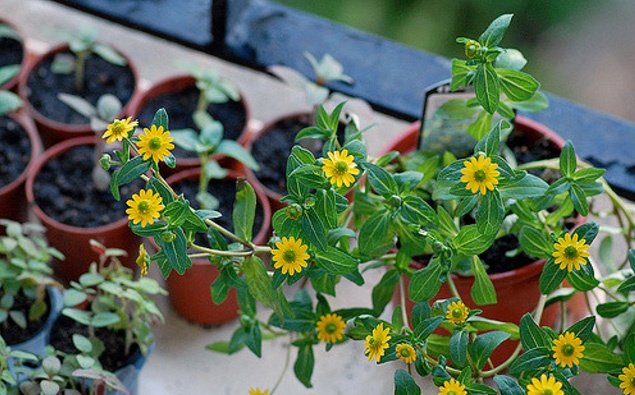
For planting, choose a loose fertile garden soil, which is mixed with coarse sand. The sand is pre-washed. The seeds are deepened by 5-10 mm and sprinkled with earth. Upward watering is preferable, for which a high sump is constructed. To reduce evaporation, the surface is covered with polyethylene or glass until shoots form. In favorable conditions, they will appear together 10-12 days after planting.
The greenhouse is periodically ventilated. This helps to remove excess moisture and harden the seedlings. After the appearance of two true leaves, the seedlings dive and plant in open ground. For this, they choose sunny places in the garden with well-drained soil.
Shallow pits (up to 10 cm) are dug at the landing site, on the bottom of which brick chips, expanded clay or other small stones are poured. They will provide air access to the roots. The fact is that the root system is very sensitive to moisture and rots easily. A distance of about 25 cm is left between the bushes.
In the south of the country, you can sow seeds directly in the garden in late May or early June. After the appearance of sprouts from 10 cm in height, too dense places are thinned out.
"Suns" of the Siberian summer
Annual plants used for decoration are commonly used in landscaping, both in clean plantings and in combination with perennials. Rich and long flowering, unpretentiousness, resistance to bad conditions are highly appreciated by both amateur flower growers and landscape decorators. Based on the long-term skill of communicating with both those and others at a variety of courses and exhibitions, it can be emphasized that very often they ask questions about how the plants selected for landscape projects will form in certain natural and climatic conditions.
Annuals are indispensable in Siberian gardening, because even the southern, forest-steppe part of Western Siberia is characterized by harsh climatic conditions (long severe winters, late spring and early autumn frosts). Summer is hot here, but very short, thanks to this it is important to quickly create a decorative effect. This can be achieved in 2 ways: 1) the choice of annuals with a short pregenerative time (PG, the time from germination to the emergence of buds) is selected; 2) the seedling method of cultivating annuals with PG is used for more than 45 days.
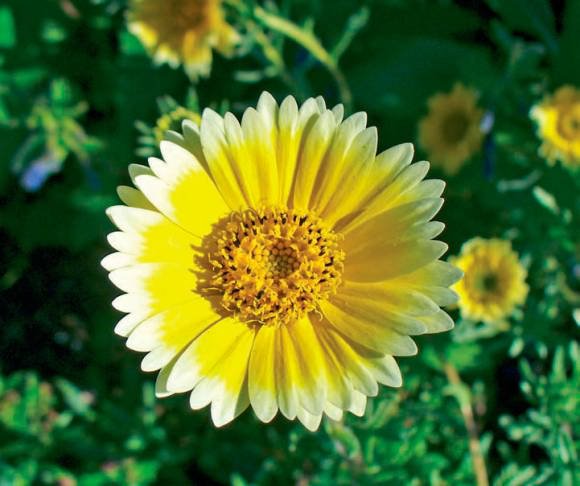

Leia is beautiful
Asteraceae (Asteraceae) are classically promising plants for landscaping. Representatives of this largest family are very popular around the globe and are represented on 6 continents in all climate zones. Asteraceae occupy a very far from the last place (taking into account the varietal diversity of them, there are about 120) in the introduction collection of annuals of the Central Siberian Bot. garden SB RAS (Novosibirsk), where they account for about 30% (31 genera, 42 species). A big contribution to their introduction into the Central Siberian Gardens in the 60-70s. of the last century was introduced by Ph.D. L.P. Zubkus.
The Aster family consists of 2 subfamilies, subdivided into 18 tribes. In this publication, we want to talk about ornamental summer cakes belonging to the sunflower tribe (Heliantheae). This is the most annuity tribe, although not the most luxurious in terms of the number of species, including 210-220 genera and no less than 2500 species. They are popular in all regions of the New World, and in the Old World they are confined mainly to the tropics and subtropics, only species of the genera Bidens and Arnica enter temperate and cold regions [1].
All sunflower leaves are opposite, in inflorescences-baskets along the edge there are false-lingual flowers, and in the very center - tubular. Pappus (crest, parachute, fly - a modified calyx of a flower; a set of hairs (thorns, scales) extending from the pericarp) is an unusual distinctive part of the aster flower - in sunflowers it is provided in the form of films, bristles, but not hairs, as, for example, in a dandelion belonging to the tribe chicory. In the series (Bidens), the pappus consists of 2-3 setae with notches directed downward. Due to this, achenes cling to the wool of animals or human clothing and are carried over long distances. But in the sunflower, the pappus is represented by filmy scales that do not carry any special function.
Leia is beautiful
Sanvitalia prostrate
Tithonia round-leaved
Spilantes garden
Among the flowering plants, the tribe sunflower for flower decoration of Siberian megalopolises promising species from the genera Gaillardia, Coreopsis, Cosmos, Leia, sunflower, Titonia (seedless growing method), Sanvitalia, a string (seedless and seedling), dahlia, rudbeckia, zycinia ...
Most of these plants (Gaillardia, Coreopsis, Cosmos, sunflower, dahlia, rudbeckia, zinnia) are widely known and successfully used by amateur flower growers for flower decoration of their own garden areas.However, one should not discount such annuals as leia, titonia, sanvitalia, string, spilantes, which are not inferior to the first ones either in decorativeness or in practicality.
Leia (Layia Hook. Et Arn. Ex DC.). Homeland - North America. About 13 species are known (small herbaceous annuals). In floriculture, beautiful leia is used from California.
Leia is beautiful (Layia elegans Torr. Et Gray). Plants 20-50 cm high with a branched stem. The leaves are whole or deeply toothed, gray-green, with a good odor. Inflorescences are bright, golden-yellow, 4.5-5 cm in diameter, on long peduncles. Ligulate flowers with whitish ends and notches along the edge of the limb. It blooms well, the seeds ripen in the Siberian climate, retaining their germination capacity for 3-4 years. This light-loving plant grows very well on any soil, but better on light, well-drained soil. The seeds are sown in the soil in mid or late May. Blooms in early or mid-July. The transplant does not tolerate well. Recommended for curbs, stone gardens, cutting.
Titonia (Tithonia Desf. Ex Juss.). Homeland - Mexico and Main America. About 10 species are known (herbaceous, strong, branched, sometimes lignified at the very base, one or perennials).
Tithonia rotundifolia (Mill.) Blake) naturally grows in Mexico. It is an annual plant with a height of 120-150 cm with a straight, branching, hollow stem with silky pubescence. The leaves are large, light green, whole, cordate, on petioles. Inflorescences 6-7.5 cm in diameter, on long peduncles. Reed flowers are orange-yellow or scarlet, placed in one row; tubular - golden yellow.
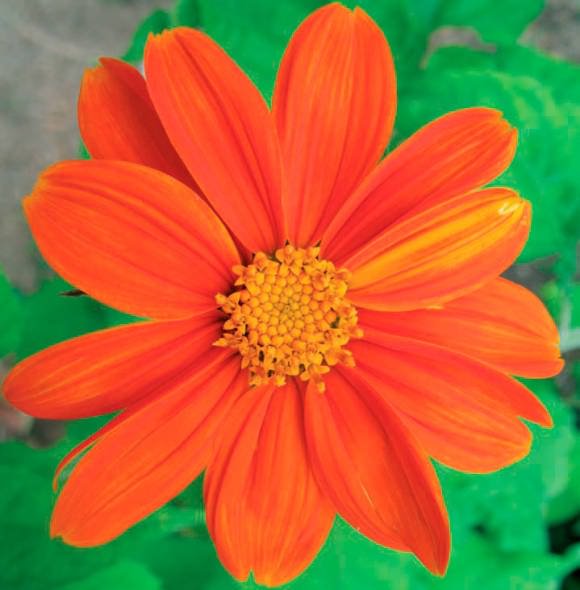

Tithonia round-leaved
The spectacular bloom lasts from mid-July until frost. Seeds ripen, keep germination up to 3 years. The plant is light and heat-loving, easily damaged by frost. Grows well in open, sunny places with black soil. They grow in a seedless way, sowing is carried out in mid-late March. The transplant does not tolerate well. For group landings.
Sanvitalia (Sanvitalia Gualt. Ex Lam.). Homeland - Home America. 4 species are known (herbaceous, strongly branching annuals).
Sanvitalia procumbens Lam. Plants up to 35 cm high, with creeping shoots, forming wide, spreading bushes. Stems are highly branched, reliable, slender, reddish on the illuminated side. Leaves are opposite, ovate, on short petioles or practically sessile, broadly oval, entire. Inflorescences with a diameter of 2-2.5 cm, countless, the most practical, with a convex dark brown or almost black disc of tubular flowers; ligulate flowers are yellow, orange-yellow or white, placed in one row along the edge of the basket.
The flowering is rich, constant, until frost. Seeds ripen, keep germination for 2-3 years.
Sanvitalia is a warm and light-loving plant, not demanding on soils, resistant to drought. Does not tolerate frost. In partial shade it develops well, but the number and size of inflorescences become smaller. They are grown in seedling and non-seedling methods. In the first version, the seeds are sown in the greenhouse in mid-April, by the time they are planted in open ground, the seedlings are already blooming. She tolerates the transplant perfectly. In another version, the seeds are sown in open ground in mid-late May, then flowering comes in early July. Truly bushy, looks very good on rocky areas. For low curbs, flower beds, rock gardens.
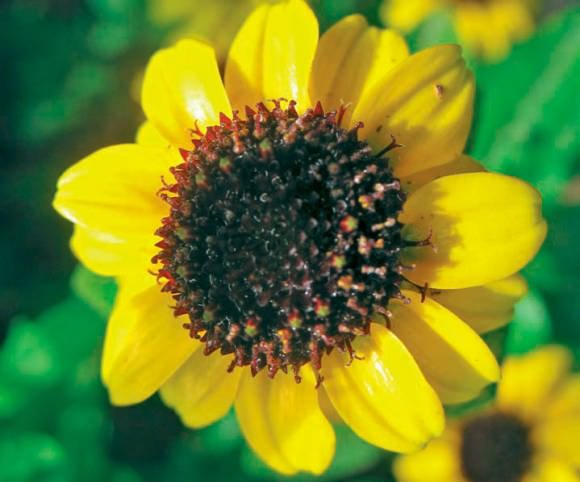

Sanvitalia prostrate
Varieties differ in color tone and small bush size. So, ‘Honey Spas’ stands out for its colorful palette of flowers and large inflorescences, ‘Orange Sprite’ has semi-double, orange baskets, and dark green leaves. The 'Mandarin Orange' bush is strewn with bright orange buds with a black eye. ‘Irish Eyes’ have orange reed flowers and a green center, which consists of tubular flowers. The 'Sunbin' variety is perfect for hanging baskets.
String (Bidens L.). Homeland - Mexico, Guatemala, the south of the United States. There are 247 known species (perennials and perennials that prefer damp habitats). In floriculture, 1 species is widespread.
Feruloliferous string (Bidens ferulofolia (Jacq.) DC.). A perennial from the southern regions of North America, grown in Siberia as an annual.Undemanding lush bushy plant 40-90 cm high. Countless growing very quickly spreading shoots (their length up to 60 cm) form a ball or hang down. The stems are robust, branching from the base of the bush. The leaves are dark green, strongly dissected, resembling lace. Inflorescences - countless bright yellow baskets, about 3.5 cm in diameter, appear constantly from the end of June until the prolonged autumn, lure many bees and butterflies. Achenes are oblong, dark brown or blackish with 2 clinging bristles.
The bloom is rich, from June to frost. The seeds ripen quickly, in a significant amount, but are not visible, due to this they do not reduce the decorativeness of the plants. They keep germination for 2 - 4 years.
It is cold-resistant (tolerates a temperature decrease to minus 5 ° C), drought-resistant plant during the period of heavy rains can grow out. Prefers a sunny location, but actively develops in partial shade. They are grown in seedlings (seeds are sown in a greenhouse in late March-early April) and in a seedless way (in early spring in open ground). Seedlings appear 10 days after sowing. In the first version, flowering comes in mid-June, in the other - about a month later.
Watering is calm. In order for the flowering to be abundant, phosphorus-potassium dressings are needed, which are carried out at intervals of 10-14 days. Shoots can be shortened if desired. Even after a strong pruning, after 14 days, buds begin to develop on the plant again. Planting should not be thickened, otherwise decorativeness decreases. It is offered as a carpet plant, for flower beds and borders, rocky gardens; well suited for containers, balcony boxes, hanging baskets.
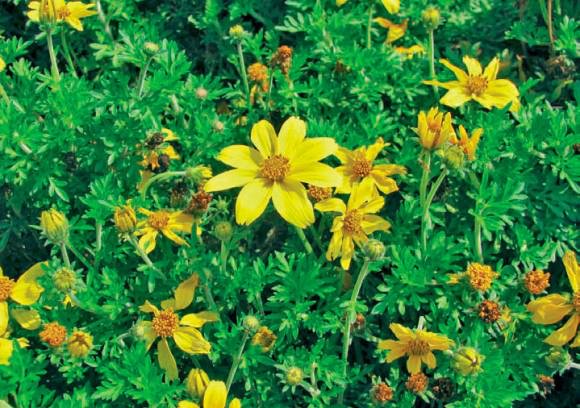

Feruloliferous string
The cultivars are slightly different from the original wild-growing form: 'Goldie' has slightly short and wider leaves, while 'Golden Goddess' has very large inflorescences. The 'Samsara' bushes are small and are recommended for planting in hanging baskets, as is the 'Sunshine' variety with drooping shoots.
Spilantes (Spilanthes Jacq.). Homeland - Brazil. About 7 species are known (herbaceous annuals with plagiatropic shoots growing parallel to the substrate surface).
There are several species in culture: Spilanthes oleracea L. and oilcress (Spilanthes acmella L.). These plants are up to 40 cm high with creeping shoots. The leaves are long-petiolate, broad-ovate, opposite, whole, oval, truncated at the very base, dark green, acquire a bronze tint in the sun. Inflorescences are golden, oblong, with a cherry eye, 2 to 3 cm in size. Spilantes seeds are flat, very small, wedge-shaped, 2-3 mm long, 1.2-1.3 mm wide, dark gray, dull. Spilantes grows like a carpet plant, the diameter of which can reach 80 cm.
A special variety of Spilanthes acmella ssp. fusca with brown leaves is called Brazilian watercress.
Rich bloom, from late June to frost. Seeds ripen in Siberia, keep germination for 2-4 years. The plant is light and heat-loving, drought-resistant, easily damaged by frost. Grows well in open, sunny places with black soil.
They are grown in seedlings, sowing is carried out in greenhouses in the last days of March. Friendly shoots appear very soon. They are planted in the soil after June 10. She tolerates the transplant perfectly. Responsive to feeding. For curbs, creating compositions on lawns. Can be grown as
carpet plant. Looks great in hanging pots and tall containers. Perfectly combined with vegetation with bright or silvery foliage (dichondra, cineraria, etc.)
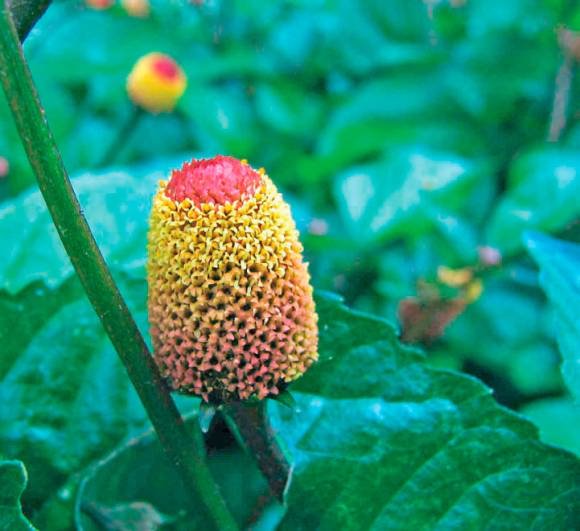

Spilantes garden
In addition to its decorative qualities, the plant has a pleasant, piquant taste and aroma. The leaves contain spilanthol, an analgesic substance.It is cultivated in the tropics and subtropics of the two hemispheres as a salad, ornamental and medicinal plant. In the Russian Federation, Spilanthes oleracea 'Peek-a-Boo' is known with shiny dark green leaves with an olive peak.
1. Kamelin RV Composite (a small review of the system). - Barnaul: ASU, 2000.- 59 p.
2. Takhtadzhyan A. L. The system of magnoliophytes. - Leningrad: Nauka, 1987. - S. 266-272.
3. Baykova EV Characteristics of seedling and seedling culture of decorative annuals in the forest-steppe zone of Western Siberia. - Bulletin GBS, issue 168. - M .: Nauka, 1993 .-- S. 130-135.
4. Baykova EV Introduction of decorative annuals in Novosibirsk. GBS Bulletin, no. 178 .-- M .: Nauka, 1999 .-- S. 77-81.
The magazine "Floriculture" № 1 - 2019
Growing and caring for mature plants
In the garden for sanitation, open sunny places with moderately fertile soil are suitable. Be sure to take care of good drainage. It is important to do periodic weeding to aerate the roots and remove weeds.
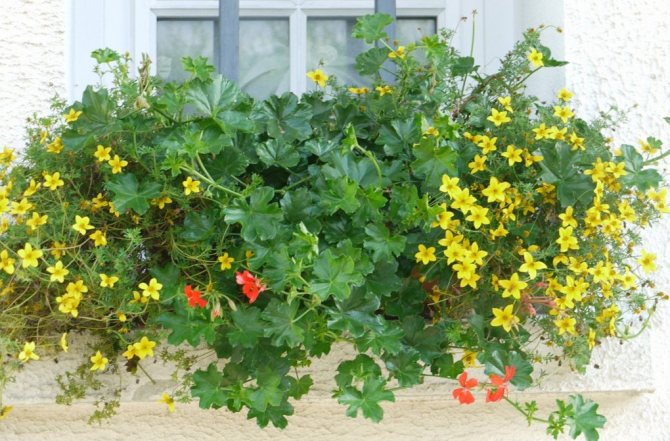

Watering is needed in moderation, in a damp summer there is enough rain moisture for normal growth. Lack of water does not affect the abundance of flowers. The bushes are also resistant to wind, although strong gusts can disrupt their shape. To avoid this, use frame props.
The root system tolerates transplanting well, it can be carried out even in the presence of flowers. If the bush needs to be moved to a new location in the garden or a more spacious planter is selected, this will not lead to a decrease in flowering or plant disease.
Read also Honeysuckle honeysuckle planting and care in the suburbs
For good growth during the transplanting period and the formation of buds, it is necessary to apply fertilizers. Liquid complex mineral dressings are usually used. Fertilize sanitation twice a month.
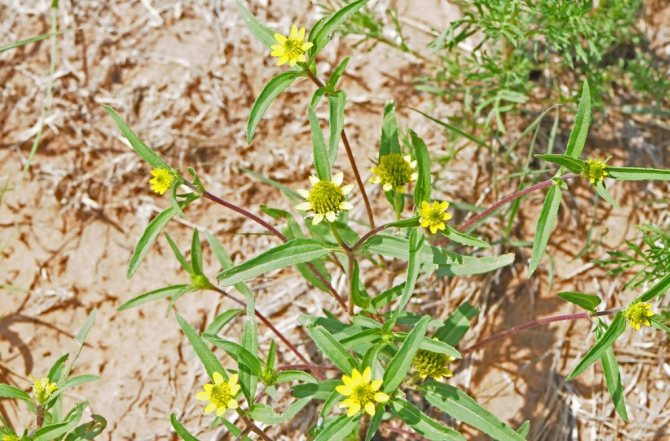

The plant is thermophilic and hardly tolerates strong temperature changes. It can survive in short-term frosts down to -3 ° C. To prolong the existence of flowers, they are transplanted into flowerpots and brought into the room. The optimum temperature is not lower than + 5 ° С.
How to grow seedlings
Sanvitalia is an unpretentious plant. Therefore, even a novice gardener can grow it. To sow the seeds correctly, you will need to carry out the following manipulations:
- prepare a container of the appropriate size for planting seeds;
- fill the bottom with drainage material;
- fill the container with soil, which is ideal for a mixture of clay and coarse sand (3: 1);
- very small seeds of sanvitalia should be scattered over the surface and lightly sprinkled with earth;
- spray crops from a spray bottle;
- arrange a small greenhouse made of transparent material, such as glass or polyethylene.
Sanitary needs a sunny spot in the garden
Sanitary seedlings appear within 14 days, after which the shelter is removed. Young plants are watered by spraying from a spray bottle. This prevents damage to the seedlings by the water jet. A dive into separate small containers is carried out after the formation of two leaves. You can put several pieces in one dish. In warm regions, you can immediately sow sanitation in the ground.
Attention! Do not sow seedlings before mid-April. Overgrown plants can stretch out and die.
With the onset of stable warm weather, sanvitalia seeds can be sown directly into the ground and then thinned out. But it should be borne in mind that it will bloom in this case much later.
Possible problems
This disease resistant plant is rarely a hassle. Still, it is important to inspect the shoots periodically to prevent serious problems.
If the bases of the stems begin to darken, this indicates a violation of the root system. Perhaps due to stagnant moisture, rot has appeared. It is necessary to let the substrate dry out and loosen the soil well. Thinning is carried out in too dense thickets. If you do not take any measures, the plant can quickly die.


The appearance of light twisted leaves indicates a lack of moisture. In extremely dry weather, this is possible. It is enough to increase watering for sanitation to come back to life. Small flowerpots with drainage holes can be completely placed in a tub of water for 1-1.5 hours. After that, the containers are removed and the water is allowed to drain.
How to plant sanitation in a permanent place
Two weeks before the planned planting, it is necessary to start hardening the seedlings. To do this, pots with grown sanitation for a day are put out on the street or on an open balcony.
You need to choose a sunny place for planting in the garden. In shading, sanvitalia practically does not bloom and is strongly stretched. A layer of broken brick or other drainage material should be poured into small holes prepared in a flower bed for planting a plant.
Attention! The root system of sanvitalia is very sensitive to moisture and quickly decays. Therefore, a drainage device is required when planting. The interval between the bushes must be left at least 25 cm.
Using
Sanvitalia will decorate open flower beds, balconies and a veranda. In independent plantings, it creates the effect of shimmering sunlight on the site or in a flowerpot. Can be used in compositions with other plants of contrasting flowering. It goes well with sweet peas, nasturtium, salvia, cinquefoil, forget-me-not and other annuals.
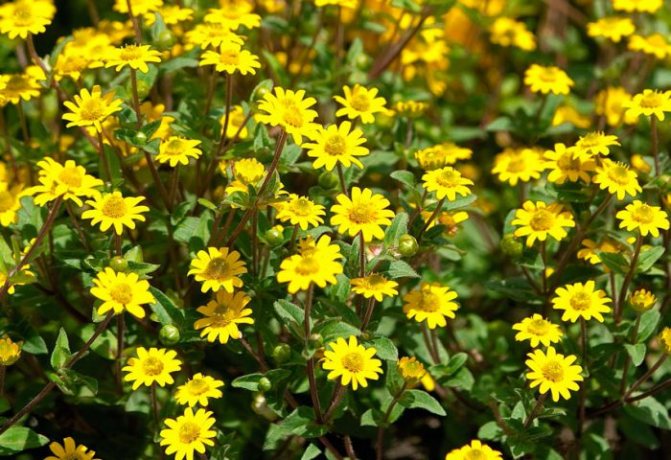

A short herbaceous annual or perennial plant Sanvitalia is a member of the Asteraceae or Asteraceae family. This genus unites only 7 species. In natural conditions, such plants can be found in Central and North America. This genus was named after the Italian, Sanvitali, who was a botanist. The most popular among gardeners is such a type as recumbent or prostrate sanitary (Sanvitalia procumbens), it has been cultivated since the 18th century.
Common plant diseases
Like any other plant, sanvitalia can suffer from the following problems:
- Blackleg. As a rule, it is the seedlings that suffer from this disease, which occurs under the condition of improper and excessive watering. It is important to remember that seedlings need proper air circulation. Therefore, the seedlings are watered only through the pallet, they are not planted too densely. For watering, you need to take a large pallet, pour warm, settled water into it and place a pot or container with seedlings for 10 minutes in it.
- Twisted leaves. This symptom is the main sign that the plant needs additional watering. Sanvitalia tolerates drought well enough, but if the leaves begin to curl, then the flowers need to be watered, and the recovery process occurs very quickly.
Sanvitalia - suns in your garden
Sanvitalia is an annual ornamental plant from the Asteraceae family. In the natural environment, it grows in Central and South America. It is used to decorate the garden landscape, mainly in hanging baskets, as shown in the photo of the sanitary facility.
Features of sanitation
Sanvitalia's bushes have a spherical shape, and in height they reach no more than 20 centimeters. The length of the creeping strongly branched shoots is about 0.45 m. Opposite leaf plates, painted in a deep green color, have a petiole and an ovoid or oblong-ovoid shape. Baskets-inflorescences reach 25 mm in diameter, they include marginal ligulate flowers of yellow, orange or white color, as well as median tubular flowers, painted in brown, violet-black or pale green. Sanvitalia blooms in the second half of the summer period, and fades in October. The fruit is an achene.
You can grow this flower in balcony boxes, in hanging baskets, in rockeries, they can decorate an alpine slide or frame flower beds and garden paths. And sanvitalia is also used as a ground cover plant. This plant is not only compact, but also unpretentious, therefore it is very often grown both in the open field and in indoor conditions. Sanvitalia is recommended to be combined with forget-me-nots, iberis, nasturtium and salvia.
Sanvitalia-ground cover and ampelous sunflowers
Sanvitalia prostrate Is a rather original creeping annual. Its seeds have recently appeared in our sale. This floral plant is used very often where it is necessary to quickly and tightly close the soil. The Sanvitalia genus numbers 7 herbaceous annual and perennial species.
As an ornamental plant, a single species is grown - an open sanitary.
The endlessly branching shoots of the sanvitalia with flowers resembling a sunflower, almost very quickly form a dense carpet. At the same time, the stems can reach 45 cm in length, and no more than 15 cm in height.
She comes from Mexico, thanks to this, it is very light and thermophilic, but, regardless of this, it blooms well both in dry and rainy summers.
Small inflorescences with a diameter of 1.5-2.5 cm constantly appear over the saturated foliage from July to the very snow!
Their core is light brown or golden-green, depending on the variety, framed by yellow or yellow-orange reed flowers.
Sanvitalia blended well with the company of yellow-flowered plants, a carpet of its sunny flowers can raise your mood even on a damp, uncomfortable day.
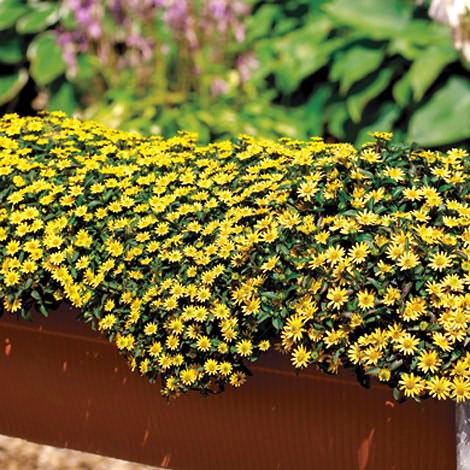

Plus, it's easy to grow from seed. They can be sown both for seedlings in March and in open ground in May. Sanvitalia bloom begins 2-2.5 months after sowing, thanks to which the seeds can be sown specifically in open ground. This is suitable for those who do not like to tinker with seedlings.
The sanitary seedlings tolerate transplanting well enough, they are only afraid of frost during the period of disembarkation in open ground. Thanks to this, it is better to harden the seedlings before planting.
If you put sanitation in hanging baskets in a configuration with other letniks of contrasting colors (Iberis bitter, mesembriantenum, nenophila, salvia, salniglostis, cymenaria, lacfiola, fragrant peas, nasturtium, forget-me-not, pinnate cloves, cinquefoil, blue, blue cascades, etc.), there will be many beautiful cascades down.)
It is also suitable for cladding flower beds.
So far, sanitation is not very popular not only in our country, but also abroad, but it's a pity - this plant is great for lovers of sunny colors.
Nostalgic garden - how to choose flowers
Annuals - space for art
for you Galimax
A series of messages "ANNUALS":
Part 1 - Flowers - planting annuals with seedlings (Glazinov) Part 2 - Cuttings of petunias. Part 13 - Technique of growing thermophilic annuals Part 14 - Gypsophila (kachim) - genus cloves Part 15 - Sanvitalia - ground cover and ampelous sunflowers
Growing sanitation from seeds
Sowing
It is quite easy to propagate sanitation by seeds, because they have a very high percentage of germination. Therefore, do not forget to collect them in the autumn. Sowing seeds for seedlings must be done in the first days of March. To do this, a drainage layer is laid on the bottom of the bowl, which is covered with coarse sand mixed with nutritious garden soil (1: 3), the seeds are buried only 10 mm. It is necessary to fill the seeds with a thin layer of soil, then the crops are moistened from the sprayer. The container is covered with a film or glass and removed to a slightly cool place (from 18 to 20 degrees). The first seedlings should appear after 10-12 days. Do not forget to air the crops once a day and water them every two or three days, resorting to bottom watering.When two real leaf plates appear, the plants are picked, while 2 or 3 pieces are placed in one cup. After they take root well, they should be hardened for 15 days, and then planted in open ground.
Transplanting
It is necessary to plant seedlings in open soil in May – June after the night frosts are left behind. For planting, you should choose a sunny area, while taking into account that the plant needs a moderately fertile soil. Make landing holes ten centimeters deep, and do not forget to keep a distance of 25 centimeters between them. At the bottom of each hole you need to put a handful of expanded clay. Then you need to pass the plant along with a lump of earth into the hole, and cover it with soil. After the soil is slightly compacted, the planted plant should be watered abundantly.
Read also When doves start to fly
In those regions where spring comes early and it is warm, sowing seeds can be done directly in open soil in May or June. It will be possible to thin out the seedlings after their height reaches 10 centimeters.
How to grow sanitary seeds and when to sow?
It is not so difficult to grow a culture with seeds at home or in a summer cottage, since sanvitalia is an unpretentious plant. The seeds are distinguished by excellent germination. However, even despite this, it is necessary to follow a number of rules in order to grow a beautiful and abundantly flowering plant. To do this, you need to know when to sow and how to plant.
What needs to be done to grow sanitation from seeds?
- Rinse and disinfect pre-prepared containers;
- Place drainage material on the bottom of the container. Lay the soil on top. You can prepare the soil for growing a plant yourself. To do this, you need to take the following ingredients: 3 parts of clay soil and 1 part of sand with large granules;
- Place the seeds in the ground to a depth of no more than 1 cm. Sprinkle the seeds with earth. Water or spray the soil using a spray bottle;
- Cover the box with foil on top. Put on the windowsill;
- The temperature in the room where the container is located should be about 25 degrees;
- The first shoots can be found within 2 weeks;
- It is advisable to water it by spraying from a spray bottle once every 3 days. More often if the air in the room is dry. Or less often, if the air is excessively humid;
- Sometimes it is recommended to ventilate the seedlings. To do this, it is sometimes necessary to remove the film from the container;
- When two leaves appear, the seedlings need to dive. Picking is planting seedlings in containers that are large in volume. You can immediately transplant it into open ground without a preliminary dive. It depends on the climate in the region.
Sowing should be carried out in March-April. You should not do this earlier, otherwise the plants may die before planting in open ground.
Caring for sanitation in the garden
Since sanvitalia is an undemanding and unpretentious plant, it will be quite easy to grow it. Watering such a flower should be moderate. If the weather is damp outside, then the sanitation need not be watered at all, as it has enough natural precipitation. Remember that stagnant water in the soil can cause rot on the root system, while a slight drought will not negatively affect flowering. After the end of watering, it is imperative to loosen the surface of the site, and do not forget to pull out all the weeds.
In the event that the area where these flowers grow is located in a strong wind, then to maintain the shape of the bushes, it is recommended to install frame supports.
If sanvitalia is grown in a soil saturated with nutrients or you added fertilizers to it during planting, there is no need to additionally feed the plant. In other cases, feeding is arranged once every 2 weeks and a complex mineral fertilizer is used for this.
To make the plants more bushy, it is necessary to pinch the ends of the stems several times, and you need to have time to do this before the sanvitalia blooms.
You can transplant the bushes at any time. Such flowers tolerate transplanting well even during the flowering period.
Diseases and pests
Sanvitalia has a fairly high resistance to pests and diseases. Problems can arise with the plant only if the irrigation regime is violated (too abundant or too rare watering). However, remember that the plant tolerates a slight drought better than stagnant liquid in the soil. If you notice that the leaf plates of the flower have begun to curl and have changed their color, then this indicates that it needs urgent watering.
During the cultivation of seedlings, she may develop a disease such as black leg. The reason for the development of this fungal disease is cramped conditions, excessive soil moisture and lack of fresh air. For prevention purposes, do not forget to air the seedlings in a timely manner, and also develop the correct watering regime.
Sanvitalia after flowering
Since this flower belongs to the thermophilic, and the air temperature below minus 3 degrees can destroy it, sanvitalia is cultivated in middle latitudes only as an annual. However, if desired, the bushes can be saved until spring. To do this, in the autumn, they must be transplanted into a flowerpot, which is removed for storage in a cool (about 5 degrees) room.
The place of sanitation in the garden landscape
Sanvitalia bushes in height reach no more than 15-20 cm, but they grow well to the sides, forming a dense cover. Therefore, they are planted in places where it is required to cover a piece of land, for example, in the place of bulbous ones that have retired.
Sanvitalia in complex landing
The plant itself looks very modest, but it is able to shade and highlight neighboring crops, that is, it is better to plant it in mixed flower beds. Sanvitalia looks great on and in stone gardens. Potted crops can be used to decorate gazebos and terraces.
It is good to frame garden paths with this flower and use it as borders in flower beds. It can be planted as a decorative spot on one of the areas of the lawn.
More recently, sanvitalia seeds appeared in flower shops and immediately attracted the attention of gardeners. This plant is unpretentious to care for, and the blooming small flowers resemble sunny sunflowers. Sanvitalia can be grown both on personal plots and on the balcony in flower pots.
This plant is native to North America, therefore it is resistant to heat and drought. Today there are several types of sanitation, but the most interesting and beautiful are terry varieties.
Flowering begins in mid-summer (July) and lasts until the end of October, until the first frosts begin. For planting sanitation, it is worth choosing a sunny place, protected from the wind, the soil practically does not matter - it grows well both on clay and on loose soils.
The plant is grown from seeds with high germination, but this is directly influenced by various factors and, most importantly, the shelf life of raw materials and storage conditions. That is why it is recommended to purchase seeds only in specialized stores - on the package there will be a photo of sanitation, expiration date and basic recommendations for planting.
- You can sow seeds outdoors, but to get more seedlings, it is best to first grow the seedlings in containers at home. Growing senvitalia from seeds is easy. First, the substrate is prepared - the ideal choice would be a light, loose, fertile soil mixture, which can be found in a flower shop, as well as made by yourself (clay soil and sand are mixed in a 3: 1 ratio).
- A drainage layer is laid out at the bottom of the container so that water stagnation does not occur, which can provoke the onset of root rot. The soil mixture is poured, and the seeds are laid out to a depth of about 1.5 cm (no more!). A not very large layer of earth is poured on top and the soil is slightly moistened with the help of a spray gun.
- Now we need to create a greenhouse effect. For this, a simple plastic wrap is taken, which covers the container on top. Clear glass can be used. Then the container is placed in a warm and well-lit sun (the temperature in the room should not be lower than +20 degrees). After about 12-15 days, the first shoots will begin to appear. Watering the seedlings is carried out infrequently and only through the pallet. This is necessary in order to prevent the development of a disease such as "black leg".
Types and varieties of sanitation with photos and names
It has already been said above that only 1 species is cultivated by gardeners - the sanitation is widespread. However, a fairly large number of varieties and hybrids of such a plant were obtained. For instance:
- Bright eyes... The tubular flowers are almost black, and the ligulate ones have a rich orange color.
- Honey saved... This variety is distinguished by abundant flowering. The tubular flowers are dark brown, and the reed flowers are honey-yellow. During flowering, these plants create a spectacular carpet.
- Gold Braid... Bushes reach a height of 20 centimeters and grow widely. The flowers are yellow, and the central part is black.
- Aztec Gold... The yellow flowers have a light green center.
- Orange Sprite... The leaf plates are dark green, and the semi-double inflorescences are orange.
- A million suns... This ampelous variety has light green tubular and yellow reed flowers. It is necessary to care for such a flower in the same way as for another creeping or climbing plant.
Sanvitalia (Latin Sanvitalia) - a genus of low-growing herbaceous annuals and perennials of the family Astrovye, or Compositae, which includes 7 species that grow naturally in North and Central America. The genus got its name in honor of the Italian botanist Sanvitali. On personal plots, the Sanvitalia procumbens flower, introduced into culture in the 18th century, is usually grown.
The use of sanitation in landscape design
Sanvitalia is used on sunny flower beds. This is a foreground plant, suitable for framing flower beds. It is planted with blue, purslane, shaded with silvery foliage.
This plant is a good choice in places where you need to quickly and tightly cover the soil. For this purpose, it is sown with bulbous plants of the spring flowering period.
In hanging baskets, it looks great with other annuals of contrasting colors - petunia, nemophila. The sunny yellow color of its flowers gives a good mood in any weather.
Sanvitalia is suitable for growing on rocky hills. It grows quickly, withstands drought well. Bright yellow flowers look great among stones.
Location and lighting
... Sanvitalia prefers open, sunny places, although it blooms well in partial shade.
The soil
... A plant that is not demanding on fertility. It is advisable to choose an area with moderately fertile soil.
Watering
... It tolerates drought well; when planting on a flower garden, it usually does not need watering. In the case of containerized maintenance, water regularly, but be sure to provide good drainage so that excess water is poured out.
Reproduction
... Sanvitalia is propagated by seeds. Seeds remain viable for 2 years. It is usually sown in May directly into the soil. Seedlings break through to maintain a distance of 20-25 cm between the bushes. For planting in baskets, seedlings are prepared by sowing seeds in a semi-warm greenhouse in March-April. Sanvitalia seedlings tolerate transplantation well.Plants grown from seedlings bloom earlier, but if transferred to the open air early, they can suffer from the cold at night.
Flowers for me are both an outlet, and a consolation, and just a good mood. Already in winter, in January, I begin to sow the seeds of the most "leisurely" favorite plants, so that by the time the seedlings are planted, they will be in full force - many of them are already blooming. And although I grow a lot of my seedlings, there is always a temptation to try new plants. Therefore, every spring I strive to look for something interesting on the vast plant market, where every year the assortment of seedlings sold becomes richer and richer.
… I noticed my “beautiful stranger” at the flower market right away. Against the background of flowering seedlings of traditional summer plants - petunias, marigolds, levkoes, Drummond phloxes and other gardeners' favorites - this plant stood out for the abundance and brightness of unusual small flowers. Previously, I have not met this plant either in the special literature (of which I have a lot), or in nature - growing in the garden of familiar flower growers. I really liked the unfamiliar plant, fascinated by its flowers - such, you know, "sunflowers in miniature." I bought it, and I have never regretted my purchase during the whole gardening season!
And the name of this unusual annual is sanvitalia. She delighted me with her flowering all summer and until mid-autumn.
The genus Sanvitalia (Sanvitalia) unites 7 plant species native to North America. In floriculture, prostrate sanvitalia or recumbent sanvitalia (Sanvitalia procumbens) is widespread. This undersized annual plant is only 15-20 cm high and has flowing stems reaching 45 cm in length. Therefore, sanvitalia is ideal for growing in hanging baskets, window boxes, very good for decorating balconies and gardens. Throughout the garden season, this wonderful ampelous plant is covered with flowers. Although they are rather small (only 1.5-2.5 cm in diameter), they are very bright and attractive.
I note that this plant is compact and lush due to the abundance of branched stems (thin, but strong, slightly lignified), looks like a blooming dense ball due to the many simultaneously opened flowers.
Sanvitalia has a basket-shaped inflorescence with yellow marginal petals and an almost black (with purple or brown overflow) convex center. These flowers really look like miniature sunflowers; they appear continuously over dense foliage from July to October.
Elegant varieties of sanvitalia have been bred with marginal petals of yellow, orange or white, the seeds of which can be found on sale. For example: "Gold Braid", "Yellow Sea", "Oranges", "Bright Eyes", "Orange Glory", "Sunshine". The flowers of the Mandarin Orange variety have orange reed flowers, and the central tubular ones are black. My plant bought from the market had yellow flowers.
I strongly disagree with the opinion of some flower growers that sanitation cannot be attributed to popular flower beds! In addition, floriculture publications recommend Sanvitalia as a suitable plant for growing in containers and for framing a flower bed. And for landing on an alpine slide, sanitation is also quite appropriate.
Sanvitalia is ideal as a ground cover plant for the vacated areas of the garden, which need to be covered in a short time. After all, sanitation takes root well after planting, actively grows and quickly closes the soil.
Sanvitalia loves open, sunny places; in the garden, areas with moderately fertile soil are preferred for her. Periodically loosen the soil and weed, and in a drought, sanitation needs regular watering.
I put Sanvitalia in an old kettle; determined a place for him at the foot of an alpine hill. This composition looked great! But I did not take into account one point: the kettle is the color of butter, and the flowers of the sanvitalia are also yellow, but of a more saturated color.Of course, with a contrasting color of the container (for example, blue or blue), against its background this plant would look even more spectacular!
Reproduction of sanitation.
Sanvitalia reproduces well by seeds. But they are small; outwardly very similar to the seeds of rudbeckia "To-To". For seedlings, sanvitalia seeds are sown in March or April, slightly sprinkling them with earth. In May, you can sow them in open ground, in a greenhouse.
When crops are kept in a cool (+18 degrees) light place, seedlings appear in about 1-2 weeks. Sanvitalia seedlings are kept at a moderate temperature. This plant blooms about 2 months after sowing.
Sanitary seedlings are planted in open ground at the end of May, when the threat of frost has passed. This plant tolerates transplantation well. Like all seedlings, it is advisable to harden the sanitation before planting in the garden by exposing the containers with seedlings to fresh air (in the shade) for several hours. When planting sanitary seedlings, the recommended distance between neighboring plants is 20-25 cm.
Sanvitalia is very responsive to weekly feeding. I used Kemiru-Lux to fertilize it.
Sanvitalia's seeds begin to ripen in August; they remain viable for 2-3 years.
Plant sanvitalia on your balcony or plant it in your garden, and it will delight you with wonderful abundant flowering for many months!
Do Kindly, SHARE this page on social media. networks
Syringarium. Growing and caring for lilacs in the garden. Growing potatoes under straw Growing bulbous flowers in winter. Leptosiphon
Botanical name:
Sanvitalia.
Sanvitalia flower - family
... Astrovye.
Origin
... Central America.
Description
... Sanvitalia is a small genus consisting of 7 annuals or perennials with creeping, branching shoots. Leaves are green, oval or lanceolate, with pronounced veins, 5-7 cm long, arranged in pairs. The flowers resemble a sunflower - yellow, orange or white, often with a dark center, the bloom is very abundant. The plant forms dense rounded rugs.
Varieties:
prostrate - Sanvitalia procumbens
A flowering annual herb with lodging stems up to 30 - 45 cm long. Leaves are green, lanceolate, whole-edged, sessile or on short petioles, reaching a length of 5 cm. The flowers are yellow, with oblong petals and often with a dark center, resembling a sunflower. Peduncles are thin, with a slight pleasant pubescence.
beautiful - Sanvitalia speciosa
A compact flowering annual, forming small bushes with a rounded crown up to 25 - 30 cm high. Shoots are often lodging, green or burgundy, covered with slight pubescence. Leaves are lanceolate, green, sessile. The leaf blades are slightly bent along the central vein. The flowers are yellow, solitary, appear on the tops of the shoots and reach a diameter of 2 cm. The flowering is very abundant.
Height
... 20 - 60 cm, growing rapidly.
Planting and sanitation (in brief)
- Bloom: from mid-summer to October.
- Landing: sowing seeds for seedlings - in early March, planting seedlings in the ground - in May or June.
- Lighting: bright diffused light.
- The soil: moderately fertile.
- Watering: moderate and infrequent.
- Top dressing: when grown in fertile soil, fertilizers are not needed, and poor soil is fed with complex mineral fertilizer twice a month.
- Support: strong wind can disrupt the shape of the bushes, therefore, frame supports are used.
- Reproduction: seed.
- Pests: do not amaze.
- Diseases: in the seedling period, a black leg can be struck.
Features of flower care sanvitalia
Caring for sanitation requires adherence to the following rules, which include:
1. Watering.
Moderate watering is required for normal growth and flowering, but the plant is a drought-resistant species, so there is no need for abundant regular watering.
2. Temperature.
This thermophilic plant is quite frost-resistant, but it is not recommended for the temperature to drop below -3 ° C. In this case, it is better to move it to a warm room.
3. Composition of the soil.
When growing sanvitalia in pots, the optimal substrate is a mixture of drained fertile and clay soil with the addition of sand. Weeds should be removed regularly and the soil should be loosened.
4. Location.
Grows well and blooms in sunny and open areas that are ventilated.
5. Fertilizers.
Top dressing is carried out with liquid mineral fertilizers, twice a month. Be sure to fertilize the flower after planting in the open ground, as well as during the period of bud formation.
Sanvitalia flower - description
Sanvitalia is a spherical bushes about 20 cm high with strongly branched creeping stems, reaching a length of 45 cm, and opposite bright green petiolate leaves of an elongated ovoid or ovoid shape. Inflorescences-baskets up to 2.5 cm in diameter consist of black-purple, brown or greenish median tubular flowers and orange, yellow or white marginal ligulate flowers. Sanvitalia blooms from mid-summer to October. The fruit of the plant is achene.
Read also Azalea soil suitable for which flowers
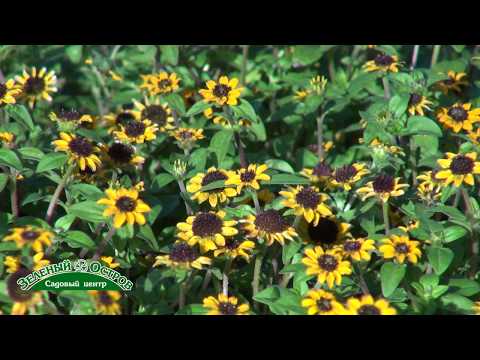

Sanvitalia is grown in hanging baskets, in balcony boxes, in rockeries and alpine slides, garden paths and flower beds are framed with bushes, and it is also used as a ground cover plant. Distinguished by unpretentiousness and compact size, sanitation at home is no less common than in the garden. It goes well with flowers such as nasturtium, forget-me-not, salvia and iberis.
Application in landscape design
With the help of sanitation, they make out sunny flower beds. The plant is planted in the foreground. Excellent cultural partners are:
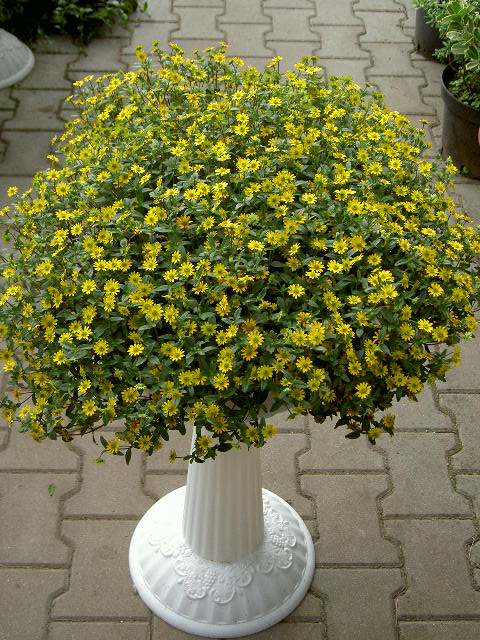

Sanvitalia in an outdoor pots.
Composition of sanvitalia, verbena, calibrachoa, fuchsia, bacopa and ever-flowering begonia.
Sanvitalia Aztec Gold as a lining of a flower border of roses (sanvitalia at the bottom left).
On the balcony.
On the retaining wall next to other summer houses.
Planting sanitation in the ground
Sowing sanitation for seedlings
Since the seeds of sanvitalia have excellent germination, it makes sense to collect them in the fall and sow in early March to a depth of 1 cm in bowls with a drainage layer and a mixture of fertile garden soil with coarse sand, prepared in a ratio of 3: 1. From above, the seeds are sprinkled with a thin layer of soil and sprayed with a spray bottle. Contain crops under glass or film on a windowsill at a temperature of 18-20 ºC. Shoots can be expected in 10-12 days. Seedling care consists in daily airing and moistening of the soil by means of bottom watering once every 2-3 days. After the formation of two true leaves, the seedlings dive 2-3 into one cup, and as soon as they take root, they are planted in the garden after two weeks of hardening.
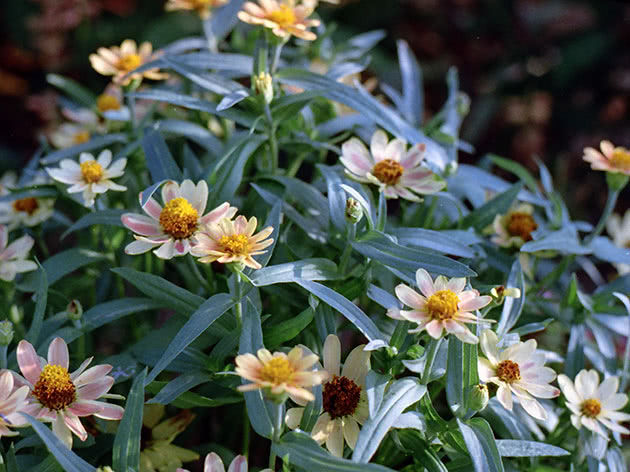

When and how to plant sanitation in the garden
Sanitary seedlings are planted in open ground in May or June, when warm weather sets in and the threat of return frosts has passed. The place for growing sanvitalia should be well lit by the sun, and the soil on the site should be moderately fertile. Dig holes about 10 cm deep at a distance of 25 cm from each other, drop a handful of expanded clay on the bottom of each, transfer the seedling together with an earthen clod into the hole, fill the remaining space with earth, lightly tamp the surface after planting and water the seedlings abundantly.
In areas with early and warm spring, seeds are sown directly into the ground in May or June, and when the seedlings reach a height of 10 cm, the crops are thinned out.
Basic rules for sowing seeds of sanitation
The cultivation of sanitation is carried out from seeds, which are characterized by a high degree of germination.This requires a substrate consisting of loose fertile soil with the addition of coarse sand, which is well washed beforehand.
It should be noted that planting material can be sown both in one container and in separate flower pots. In this case, it is imperative to provide drainage in order to exclude decay of the root system.
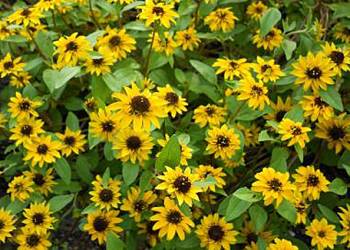

Sowing seeds is carried out in a greenhouse or greenhouse at the end of March or at the beginning of April, and a certain temperature regime must be observed in the room in the range from +18 to + 20 ° С. The seeds are not deeply buried, but only sprinkled with earth on top.
Seedlings are planted after their germination and hardening on a personal plot, as a rule, in May at a distance of at least 20 cm from each other. Sanvitalia bloom begins a couple of months after sowing the seeds.
The plant blooms with beautiful flowers of bright yellow and orange color from mid-summer to October. It is worth noting that, if necessary, you can transplant a flower that tolerates transplanting well from one place to another, and to obtain compactness, pinch it before flowering.
Caring for sanitation in the garden
How to grow sanitation
The sanitary plant is not very demanding, so planting and caring for the sanitation will not be difficult for you. Sanvitalia needs moderate watering, and in a rainy season there will be enough natural precipitation, especially since the lack of water does not affect the number of flowers, but its excess is fraught with decay of the roots. After moistening the soil, it is necessary to loosen the soil around the bushes and remove the weeds.
If the sanitation grows in a strong wind, which can disrupt the shape of its bushes, frame supports are used to solve the problem.
When grown in fertile soil or if fertilizers were applied to the soil during planting, sanitary does not need additional fertilizing, but if fertilizers were not applied, the plant is fed twice a month with complex mineral fertilizer.
To enhance tillering, the ends of the sanvitalia shoots are pinched several times before flowering.
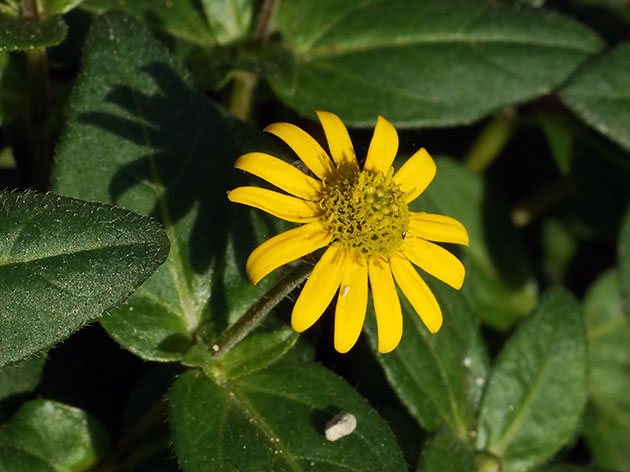

Sanvitalia transplants easily, it can be transplanted even in a flowering state.
Sanitary pests and diseases
Sanvitalia is extremely resistant to diseases and harmful insects. Problems can arise due to too intensive watering or, conversely, due to a lack of moisture, although the lack of water is tolerated by sanitation much easier than its excess. You can understand that the flower lacks moisture by its behavior: if the leaves of the sanvitalia curl and change color, it means that the plant is thirsty.
During the seedling period, seedlings can get sick with black leg - a fungal disease that occurs due to a too wet substrate, tightness and lack of fresh air, but if you regularly ventilate the seedlings and control the level of soil moisture, then this problem will not arise.
Sanvitalia after flowering
Sanvitalia is a thermophilic plant that does not tolerate temperatures below -3 ºC, therefore in our latitudes it is grown in an annual culture. But if you want to extend her life, you can transplant the sanitary plant in the fall into a flowerpot and keep it indoors at a temperature of 5 ºC throughout the winter.
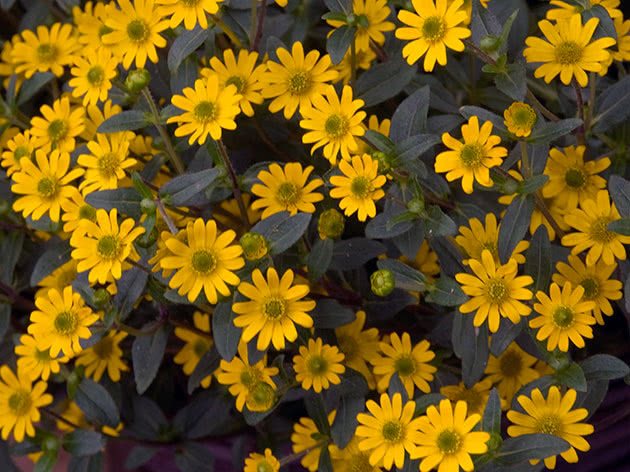

Main diseases and pests
Planting sanitation and caring for a flower is not particularly difficult, however, if conditions are violated, the plant can infect various pests and diseases.
When curling the leaves and their subsequent drying, the flower should be watered abundantly, since this phenomenon indicates insufficient watering.
Darkening of the stem has a detrimental effect, and the reason is insufficient loosening of the soil and lack of air. It is not recommended to sow seeds densely due to their high germination and subsequent abundant growth. Abundant watering leads to root rot and death of the plant.
Sanvitalia is a visitor from South America who feels great in a temperate climate. With proper planting and proper care, the plant grows well and covers the ground with a solid carpet. Small flowers, in reality and in photographs, look like little suns. How to properly grow this flower from seeds at home or greenhouse conditions? How to use the resulting seedlings in your garden design? What are the best varieties and types to choose? The answers to these questions can be obtained by studying the article.
Site selection and soil preparation
Sanvitalia grows in areas well-lit by the sun, with low groundwater levels. She needs a loose soil, good oxygen permeability, neutral reaction. Loam, refined by the introduction of sand, is suitable for the plant. On poor sandy soils, it is recommended to apply humus or compost up to 8 kg per 1 sq. meter.
If the site has heavy acidic and waterlogged soils, it is better to grow a flower in containers.
Before planting, the site is dug up, removing the roots of perennial weeds, introducing sand or humus into the ground.
Potting soil is prepared from a mixture of clay soil, humus and sand (1: 2: 1). Several granules of long-lasting mineral fertilizer for flowers are added to the substrate.
Sanvitalia - a native of Central America with an Italian name
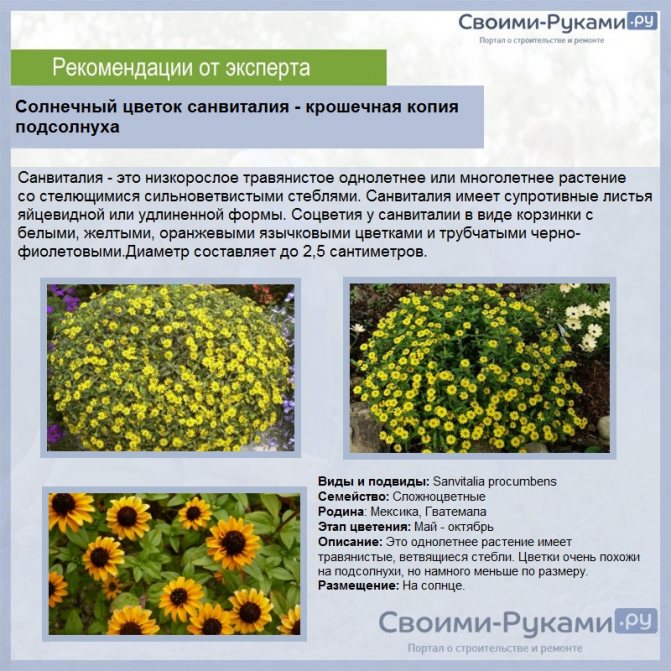

Sun flower sanvitalia - a tiny copy of a sunflower
Sanvitalia is a short annual of the Asteraceae family, characterized by a long flowering period. The homeland of this plant is Mexico and Central America, where it grows beautifully in the wild. The annual got its name from the Sanvitali family who lived in Italy. It has been used in floriculture since the 18th century, but it appeared in Russia relatively recently, but is already gaining popularity.
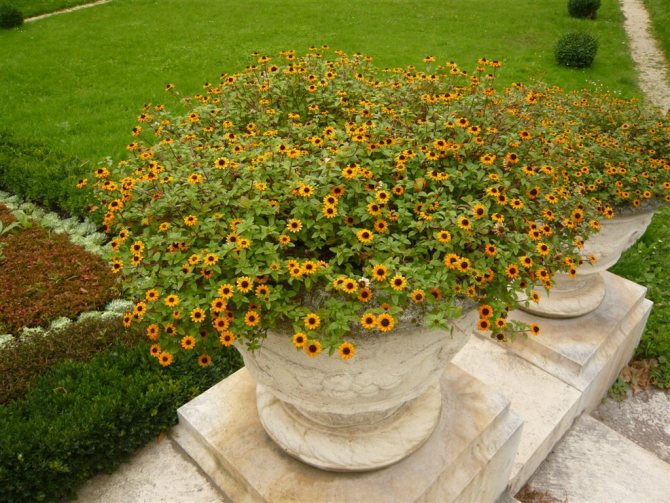

Sanvitalia: growing in a flowerpot
The genus Sanvitalia includes 7 species. On personal plots, prostrate sanitation is most often grown. The height of this bush is only about 20 cm, but it grows and branches very actively, abundantly covering large areas, which is convenient when you need to quickly close a large area of empty space. Dense, slightly lignified stems reach a length of 45 cm. The bushes are very lush and dense, resembling a thick ball in shape.
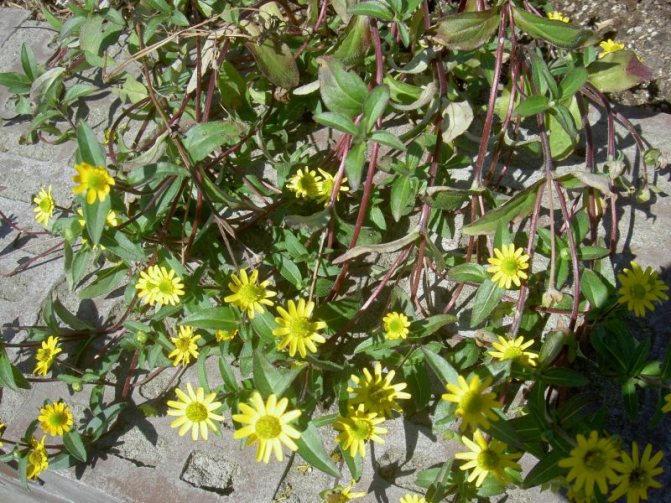

Flowers Sanvitalia
The leaves are rich green, ovoid, rather large.
The inflorescence is a basket. The flowers are very bright, yellow, orange or white with a brown or greenish core - a kind of mini-sunflowers. The diameter of the inflorescences is up to 2.5 cm. The flowering period is from mid-summer to October.
The fruit of sanvitalia is achene. Ripe seeds are very convenient to collect and then use during the new season.
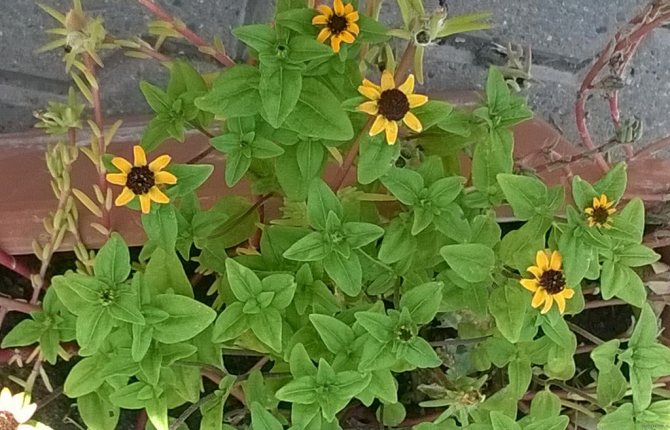

Sanvitalia prostrate
Sanvitalia is such an unpretentious plant that it feels great both in the apartment and in the garden. But more often it is still used for growing in gardens, greenhouses.
Video - Sanvitalia
How to plant in the ground
As rarely as possible, so as not to dive before planting in the ground, sowed seeds in April for seedlings. At the end of May, along the edge of the garden, at a distance of 30-40 cm, I planted it in open ground.
Sanvitalia grew very quickly, turning into a sprawling bush. She didn't pinch the tops, she bushy so well. Soon the buds appeared, and it bloomed. Its flowers are open in any weather, they last for a very long time, and the faded baskets are not at all visible behind the blooming inflorescences again and again.
Even last year's rainy weather did not spoil the flower beds - the sanitation did not wither, did not fall apart and did not lose its cheerful appearance. And it bloomed constantly until the frost.
Sanitation problems
Excess or lack of moisture can lead to diseases. It is necessary to periodically inspect the flowers to prevent their death.
If the stems are darkened at the base, an overflow has occurred.The root system has begun to rot; loosening of the soil will help to eliminate the oxygen supply and drying.
Pale twisted leaves will indicate a lack of moisture to the gardener. In this case, watering is increased. If sanitation grows in flowerpots, they can be placed in water for 60-90 minutes. After that, let the excess moisture drain and return the flower to its original place.
Growing sanitation on the balcony and in the garden
Genus Sanvitalia
(Sanvitalia) unites 7 plant species native to North America. In floriculture, widespread
open sanitation,
or
lying sanitary
(Sanvitalia procumbens). This undersized annual plant is only 15-20 cm high and has flowing stems reaching 45 cm in length. Therefore, sanvitalia is ideal for growing in and, very good for decorating balconies and gardens. The entire gardening season is full of flowers. Although they are rather small (only 1.5-2.5 cm in diameter), they are very bright and attractive.
I note that this plant is compact and lush due to the abundance of branched stems (thin, but strong, slightly lignified), looks like a blooming dense ball due to the many simultaneously opened flowers.
Sanvitalia has a basket-shaped inflorescence with yellow marginal petals and an almost black (with purple or brown overflow) convex center. These flowers really look like miniature ones; they appear continuously over dense foliage from July to October.
Elegant varieties of sanvitalia have been bred with marginal petals of yellow, orange or white, the seeds of which can be found on sale. For example: "Gold Braid", "Yellow Sea", "Oranges", "Bright Eyes", "Orange Glory", "Sunshine" (see title photo). The flowers of the Mandarin Orange variety have orange reed flowers, and the central tubular ones are black. My plant bought from the market had yellow flowers.
I strongly disagree with the opinion of some flower growers that sanitation cannot be attributed to popular flower beds! In addition, floriculture publications recommend Sanvitalia as a suitable plant for growing in containers and for framing a flower bed. And for the sanitary, too, it is quite appropriate.
Sanvitalia is ideal for vacant garden areas that need to be closed in a short time. After all, sanitation takes root well after planting, actively grows and quickly closes the soil.
Sanvitalia loves open, sunny places; in the garden, areas with moderately fertile soil are preferred for her. Periodically loosen the soil and weed, and in the sanitation need regular watering.
I put Sanvitalia in an old kettle; determined a place for him at the foot of an alpine hill. This composition looked great! But I did not take into account one point: the kettle is the color of butter, and the flowers of the sanvitalia are also yellow, but of a more saturated color. Of course, with a contrasting color of the container (for example, blue or blue), against its background this plant would look even more spectacular!
Sanvitalia: everything a tiny guest from sunny Mexico needs to thrive
Sanvitalia seedlings are kept at a moderate temperature. This plant blooms about 2 months after sowing.
Sanitary seedlings are planted in open ground at the end of May, when the threat of frost has passed. This plant tolerates transplantation well. Like all seedlings, it is advisable to harden the sanitation before planting in the garden by exposing the containers with seedlings to fresh air (in the shade) for several hours. When planting sanitary seedlings, the recommended distance between neighboring plants is 20-25 cm.
Sanvitalia is very responsive to weekly feeding. I used Kemiru-Lux to fertilize it.
Sanvitalia's seeds begin to ripen in August; they remain viable for 2-3 years.
Plant sanvitalia on your balcony or plant it in your garden, and it will delight you with wonderful abundant flowering for many months!
Galina Rusinova (Irkutsk)
All about balcony floriculture
Online
Every week, for 10 years, for our 100,000 subscribers, an excellent selection of relevant materials about flowers and garden, as well as other useful information.
Subscribe and receive!
(one-click unsubscribe)
Selection of seeds and varieties
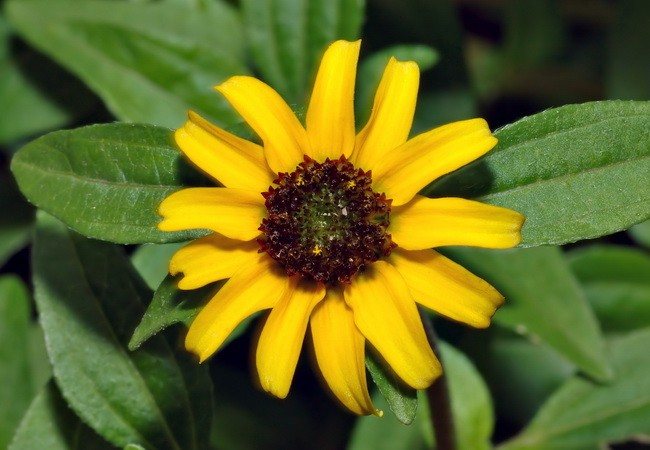

Yellow sanvitalia flower
Experienced gardeners who have already dealt with sanitation most often sow the seeds that were harvested during the previous horticultural season, because they have excellent germination for 2 years. Those who decide to grow a plant for the first time will have to go to the store in order to purchase seeds.
Despite the fact that sanvitalia seeds have good germination, it is important to choose them correctly in order to avoid mistakes:
- buy seeds from trusted producers;
- check the expiration date;
- note - the bag must be well packed;
- avoid shopping in crossings, on the streets - it is best to go to a flower or gardening store.
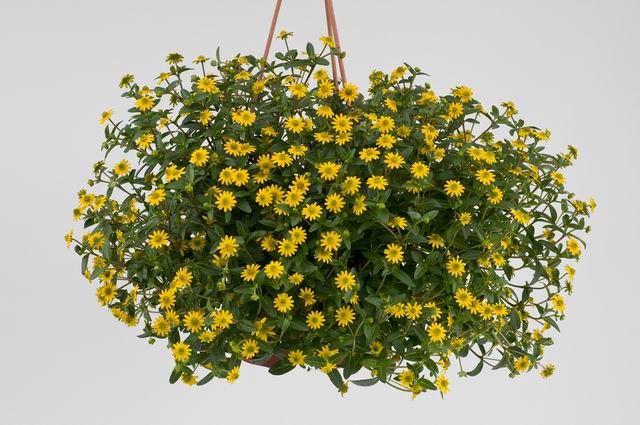

Quality seeds will grow a lush, healthy plant
There are only 7 types of sanitation. As we have already found out, in floriculture, the type "prostrate sanitation" is used. But, thanks to active selection, now a lot of interesting varieties of this plant have appeared. The most popular ones are shown in the table below.
| Variety | Description |
| Bright eyes | Produces orange-colored flowers with a black center. |
| Solar wave | The flower petals are yellow, the core is black. |
| Gold Braid | It blooms profusely in terry baskets of golden color. The middle of the flower is brown. |
| Yellow Sea | The ligulate petals (ligulate flowers) are yellow, the middle is brown. Perfectly cheers up with bright flowers even in cloudy weather. |
| Orange glory | The plant has lush orange-yellow inflorescences. |
| Suns | Inflorescences with a dark brown or black center, ligulate flowers of a rich yellow color. |
| Mandarin orange | Flower petals are ligulate, orange. The middle of the flower is black. |
And, although all these varieties have some differences, in general they are united by unpretentiousness, undemandingness to growing conditions, care and weather conditions. In addition, these plants bloom before the frost begins.
Experienced gardeners advise beginners to start working with sanitation with the varieties "Bright Eyes" and "Solar Wave".
Pests, diseases and methods of control
Pests are almost never interested in sanitation. But fungal diseases, such as black leg, often affect it at low temperatures and high humidity. Black leg is especially dangerous for seedlings, but adult plants can also suffer from this disease. Its symptoms are difficult to confuse with something: the root collar darkens, begins to soften, the leaves wither. It is almost impossible to cure diseased specimens and it is better to destroy them.
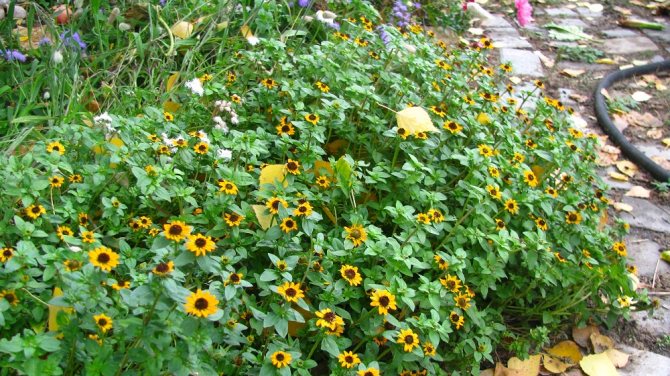

Sanvitalia often suffers from fungal diseases
To prevent the disease, it is necessary to provide the plants with favorable conditions: moderate humidity, sufficient sun and heat, timely ventilation. When seedlings with black leg appear, they must be removed and the seedlings must be treated with any fungicidal agents.
With a lack of moisture, the leaves of the sanvitalia curl and lose turgor. To restore the vigor of the plant, it is enough to water it abundantly.
Where to buy sanitary seeds?
Crop seeds are supplied by many firms and brands, including popular ones. Plant seeds can be found in many horticultural specialty stores and markets. You can also order seeds by mail or online stores.
| Variety name | Where can one buy? | Price |
| Bright eyes | 0.02 g (15 p.) | |
| Suns | Vyksa nursery | 50 p. |
| Ampelnaya | Semena Flor | 100 pieces. (22 p.) |
2. Varieties:
2.1 Sanvitalia procumbens
Flowering annual herb with lodging stems up to 30 - 45 cm long.The leaves are green, lanceolate, entire, sessile or on short petioles, reaching a length of 5 cm. The flowers are yellow, with oblong petals and often with a dark center, resembling a sunflower. Peduncles are thin, with a slight pleasant pubescence.
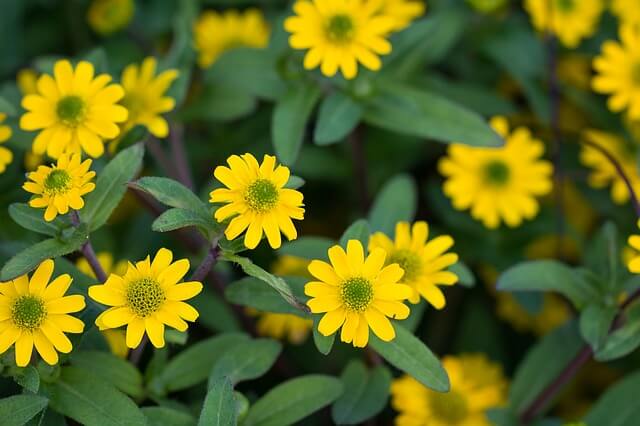

2.2 Sanvitalia is beautiful - Sanvitalia speciosa
A compact flowering annual, forming small bushes with a rounded crown up to 25 - 30 cm high. Shoots are often lodging, green or burgundy, covered with slight pubescence. Leaves are lanceolate, green, sessile. The leaf blades are slightly bent along the central vein. The flowers are yellow, solitary, appear on the tops of the shoots and reach a diameter of 2 cm. The flowering is very abundant.
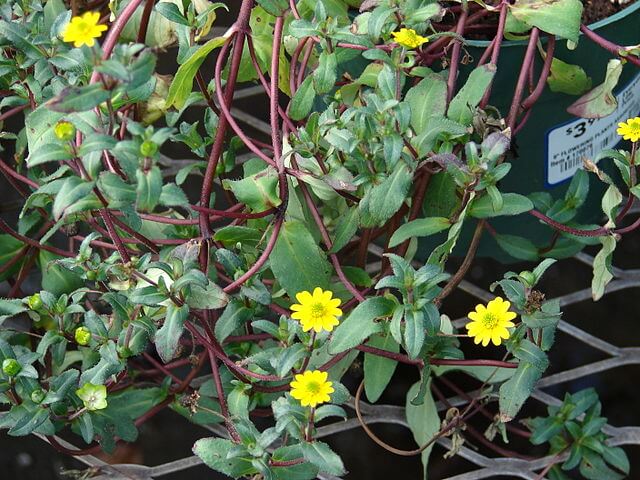

You may also be interested in:
A short herbaceous annual or perennial plant Sanvitalia is a member of the Asteraceae or Asteraceae family. This genus unites only 7 species. In natural conditions, such plants can be found in Central and North America. This genus was named after the Italian, Sanvitali, who was a botanist. The most popular among gardeners is such a type as recumbent or prostrate sanitary (Sanvitalia procumbens), it has been cultivated since the 18th century.
Essential flower care
Planting sanitation is perhaps the most difficult of the stages of growing this plant. She is very undemanding to growing conditions, and by providing her with a sun-drenched area with loose, permeable soil, you can simply let her grow as she wants to. However, during long dry periods, it is still better to water it periodically, avoiding a decrease in leaf turgor.
In watering, it is important not to overdo it: excess moisture leads to fungal diseases.
After the first wave of flowering, you can feed sanitation with complex mineral fertilizers - then the second wave will be even more abundant. But an excess of fertilizer can lead to the fact that the plant heals and there will be very few inflorescences on it.
You should also loosen the soil and weed from time to time. However, under a thick carpet of creeping shoots, most of the weeds die without the help of a gardener.
Role in garden design
A bright and rapidly growing plant is planted in flower beds with early flowering bulbs (tulips, crocuses, muscari). Sanvitalia rapidly fills the space between neighbors in the flowerbed and hides the dying leaves of primroses.
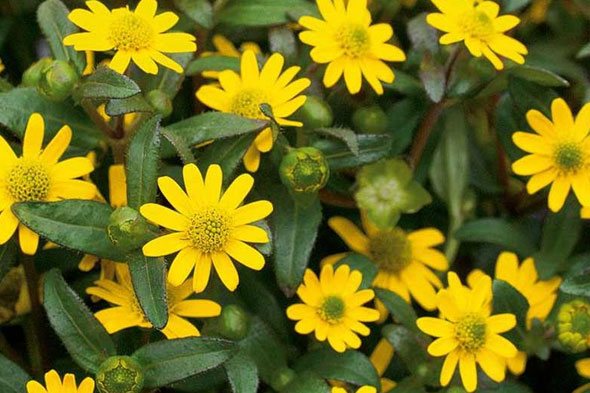

It is planted as a ground cover plant in the company of tall flowers: delphiniums, castor oil plants, mallow, climbing roses.
In flowerpots, pots and mixed flower beds from undersized crops, miniature "sunflowers" look great with geraniums, petunia, lobelia, white chamomile, viola. Golden shades of sanvitalia buds are in perfect harmony with blue, purple, white and scarlet colors.
Tags: ampelneutral soil
Use of sanitation in the landscape
Sanvitalia is often used to decorate terraces, verandas, balconies and flower beds. It is grown both in single hanging pots and in long containers. Used together with other flowers in flower arrangements. The combination with nasturtium, cinquefoil, sweet peas, forget-me-nots, salvinia and other summer flowers is especially harmonious. It is also used to decorate borders and to accentuate large lithospheric specimens such as delphinium, buckwheat or castor bean. The plant's property of densely covering the ground is used in places where bulbous flowers are grown. After their color change, sanvitalia forms a dense, bright carpet. Inflorescences look beautiful together with ageratum, lobelia, petunias, pansies, gatsania and other bright flowers.
Sowing sanitation for seedlings
Sanvitalia can be successfully grown by seed
Even the most inexperienced florist can grow sanitation at home.Seeds are sown in containers with loose, breathable moist soil diluted with coarse sand, and covered with glass, oilcloth or a plastic bag on top so that the topsoil does not dry out. Since they are very small, they should not be buried more than a centimeter. They need to be watered very carefully. In order not to erode the soil, it is recommended to spray it with a spray bottle instead of regular watering.
After 10-12 days, the seeds will germinate. When young plants have two true leaves, it is time for thinning and diving. It is imperative to provide them with enough sunlight and a temperature of about + 20-25 ºC, otherwise the seedlings will stretch out, become vulnerable to fungal and bacterial rot and may die.
Decorative properties
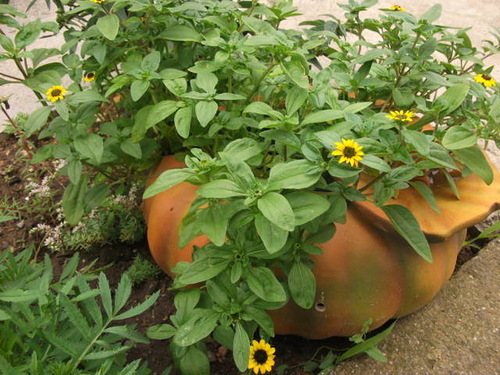

Sanvitalia in the flowerbed
The range of possibilities for using sanvitalia as an ornamental plant in personal plots and indoors is very wide. It can be used and grown:
- in hanging baskets;
- in window boxes;
- for flower bed decoration;
- in rockeries or when decorating alpine slides;
- framing garden paths;
- in boxes on balconies;
- for covering open areas of soil.
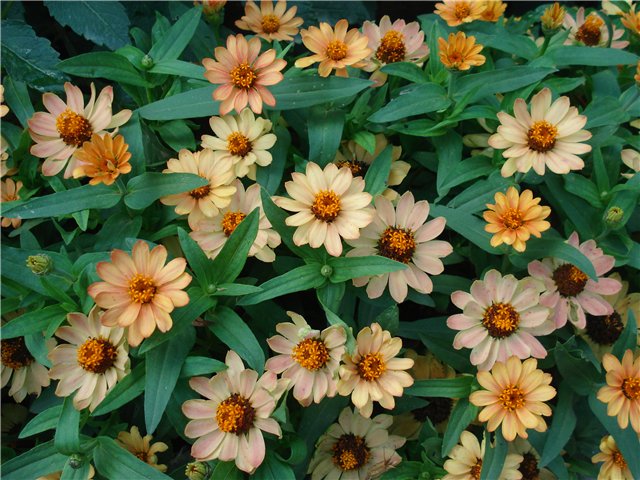

Growing sanitation in the garden
Sanvitalia goes well with other annual plants, if they have flowers of contrasting shades: a wonderful duet will work if salvia, iberis, nasturtium, forget-me-not or other plants settle next to sanvitalia.
Thanks to the simplicity of the flowers, but at the same time, possessing a host of other advantages, sanvitalia is increasingly gaining the love of Russian flower growers.
Tips for growing sanitation
Location and lighting... Sanvitalia prefers open, sunny places, although it blooms well in partial shade.
The soil... A plant that is not demanding on fertility. It is advisable to choose an area with moderately fertile soil.
Watering... It tolerates drought well, when planting on a flower garden, it usually does not need watering. In the case of containerized maintenance, water regularly, but be sure to provide good drainage so that excess water is poured out.
Reproduction... Sanvitalia is propagated by seeds. Seeds remain viable for 2 years. It is usually sown in May directly into the soil. Seedlings break through to maintain a distance of 20-25 cm between the bushes. For planting in baskets, seedlings are prepared by sowing seeds in a semi-warm greenhouse in March-April. Sanvitalia seedlings tolerate transplantation well. Plants grown from seedlings bloom earlier, but if transferred to the open air early, they can suffer from the cold at night.
Sanvitalia is the most unpretentious ampelnik
author Rusinova G.
Flowers for me are both an outlet, and a consolation, and just a good mood. Already in winter, in January, I begin to sow the seeds of the most "leisurely" favorite plants, so that by the time the seedlings are planted, they will be in full force - many of them are already blooming. And although I grow a lot of my seedlings, there is always a temptation to try new plants. Therefore, every spring I strive to look for something interesting on the vast plant market, where every year the assortment of seedlings sold becomes richer and richer.
… I noticed my “beautiful stranger” at the flower market right away. Against the background of flowering seedlings of traditional summer plants - petunias, marigolds, levkoes, Drummond phloxes and other gardeners' favorites - this plant stood out for the abundance and brightness of unusual small flowers. Previously, I have not met this plant either in the special literature (of which I have a lot), or in nature - growing in the garden of familiar flower growers. I really liked the unfamiliar plant, fascinated by its flowers - such, you know, "sunflowers in miniature." I bought it, and I have never regretted my purchase during the whole gardening season!
And the name of this unusual annual is sanvitalia. She delighted me with her flowering all summer and until mid-autumn.

